# Building Production Reports
# Production Overview
As a Producer, having a comprehensive overview of the entire production process is essential.
Kitsu offers various tools to help you stay informed and manage production efficiently without getting overwhelmed by notifications or losing focus.
# News Feed Features
The news feed section show real-time updates relating to your production, including:
- Real-Time Updates: View all status changes as they happen, minute by minute.
- Summarized View: The right part of the screen displays the total number of news items and a breakdown by status.
- Filtering Options: Filter the list by Task Status, Task Type, and Person to focus on specific areas.
- Comment Panel: Clicking on a line opens the comment panel on the right, providing all necessary details.
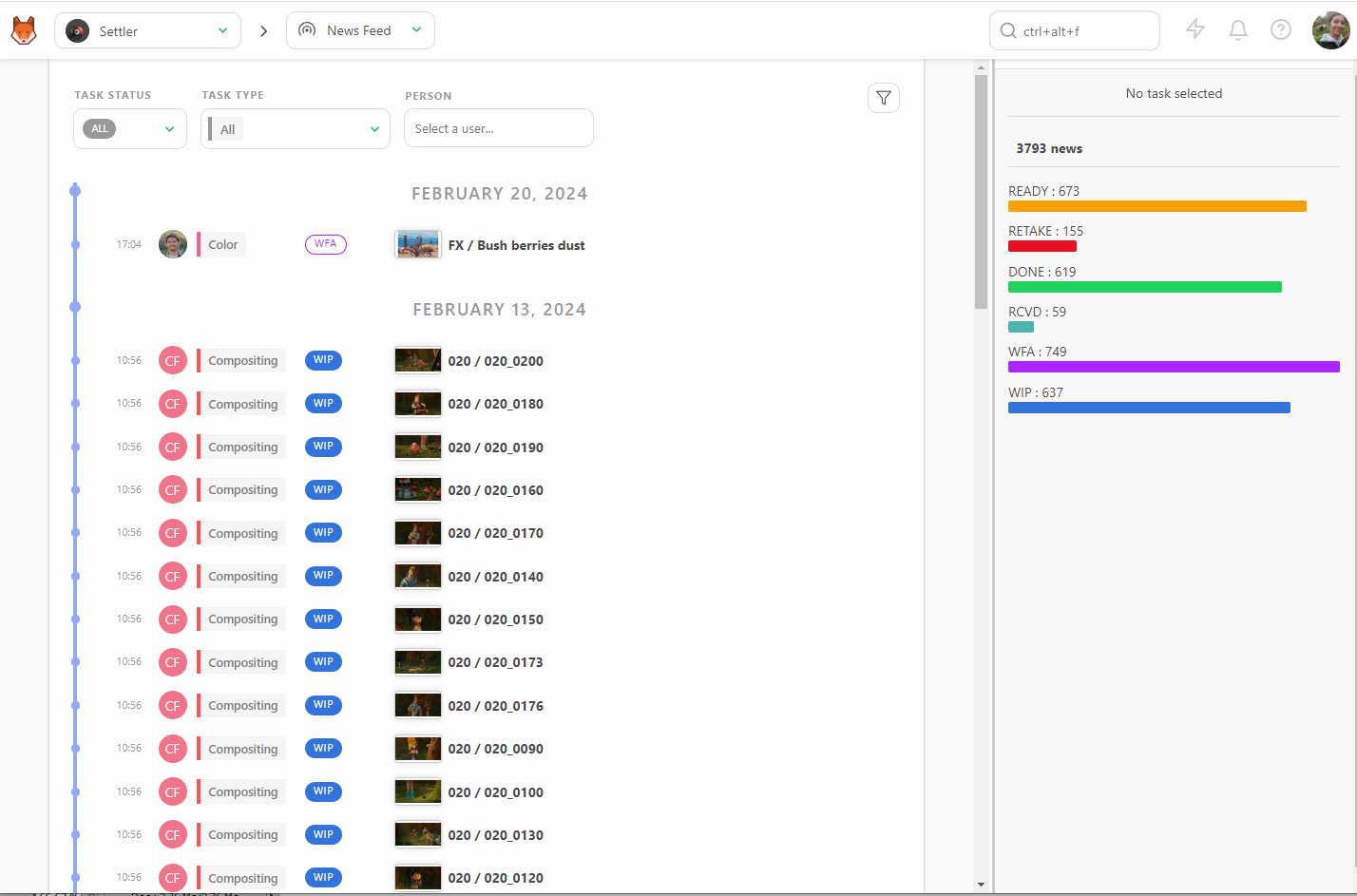
# Using Filters
You can customize the time frame for displaying information using the Filters Builder button. This is useful for focusing on specific supervisors or time periods.
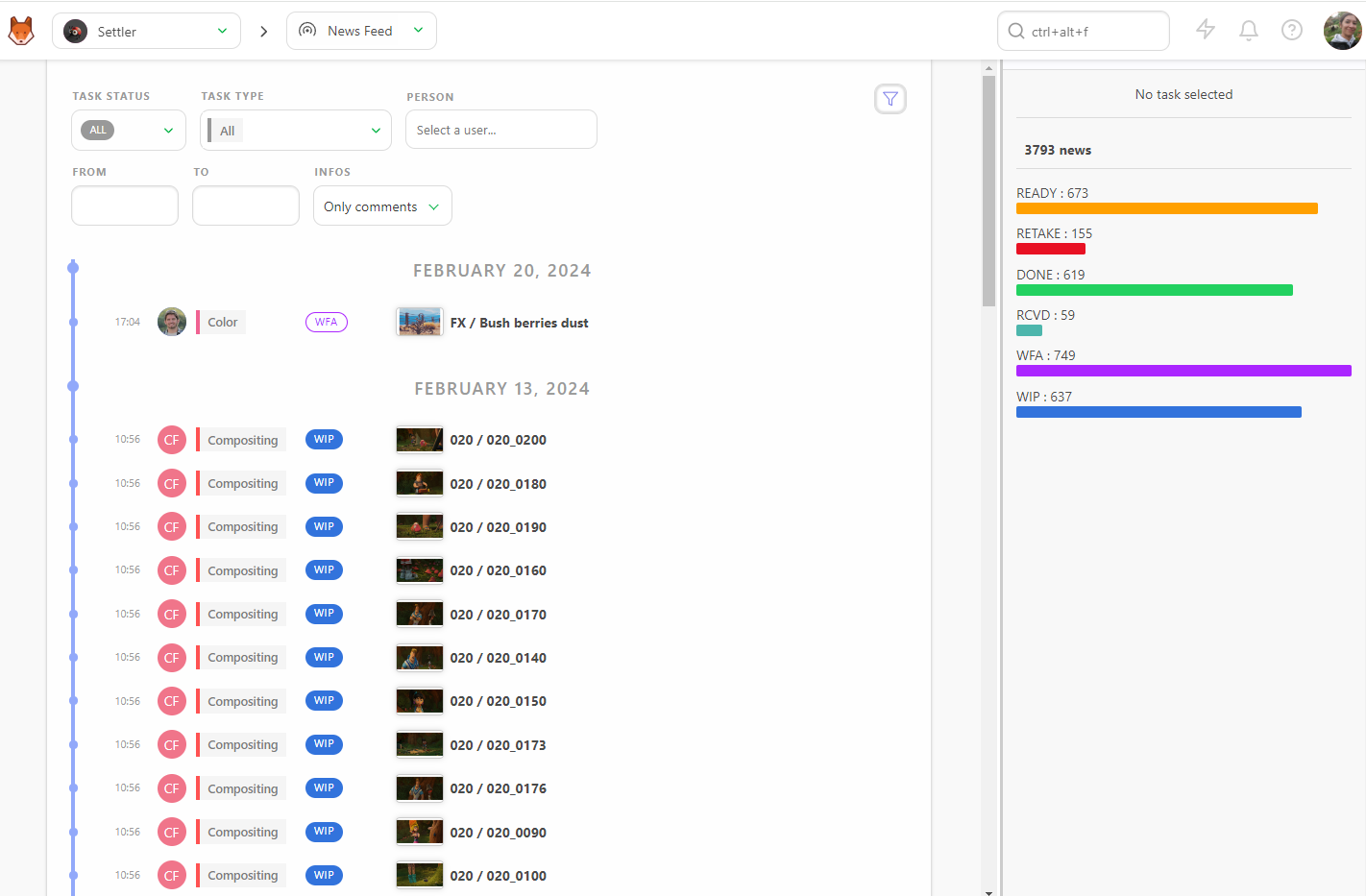
# Example
If you want to focus on a supervisor for a specific month, select their name and pick a date in the From box.
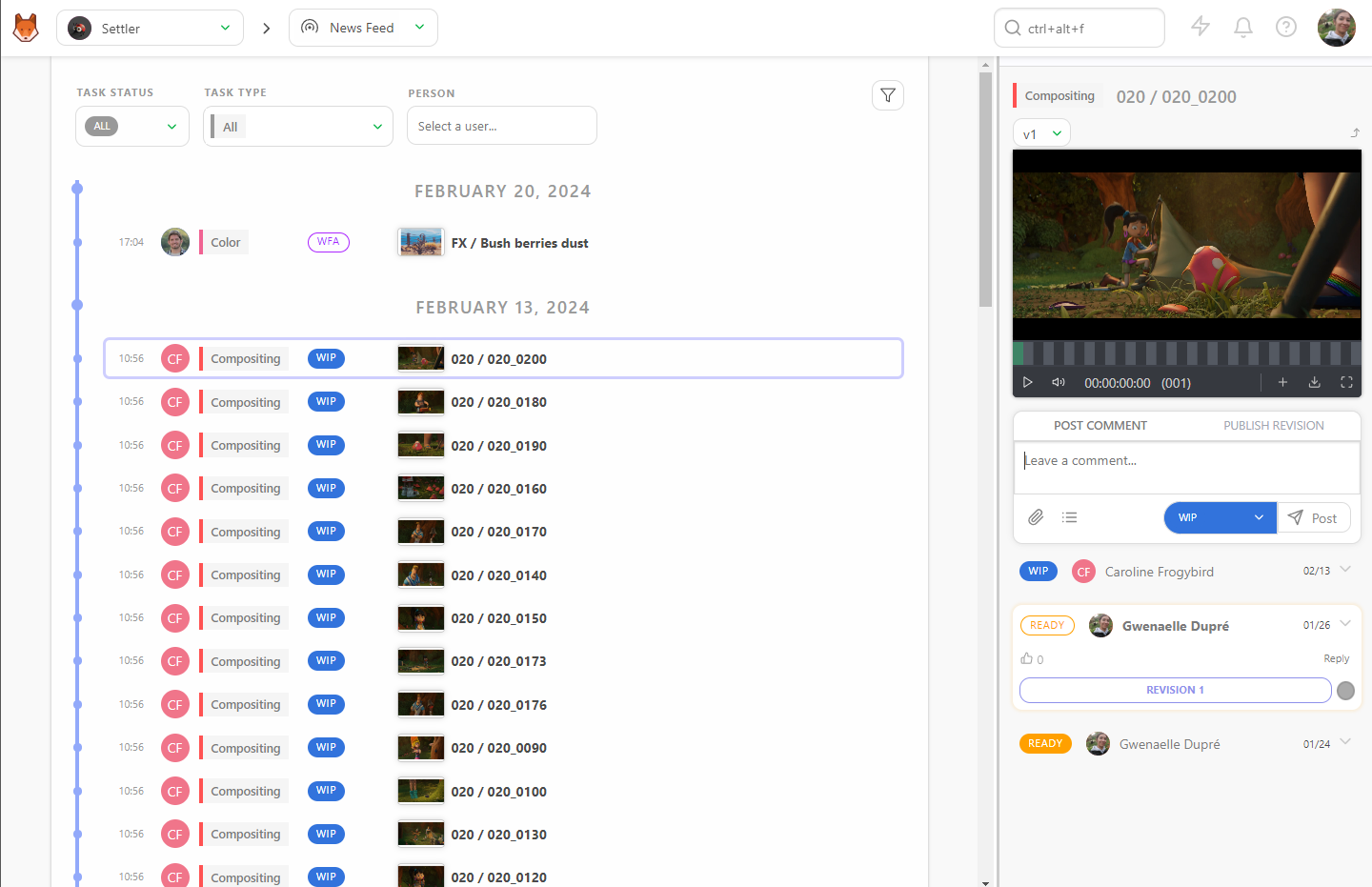
# Know the Current State of the Production
Understanding the current state of your production is crucial. Kitsu provides detailed statistics and visualizations to help you track progress effectively.
# Short / Feature Specific
We're going to look at some features that are specific to Short / Feature Film workflows.
# Sequence Stats
The Sequence Stats page offers pie charts that depict the status of your production, sequence by sequence. The color scheme of the pie charts corresponds to the status, allowing you to quickly understand the state of your production.
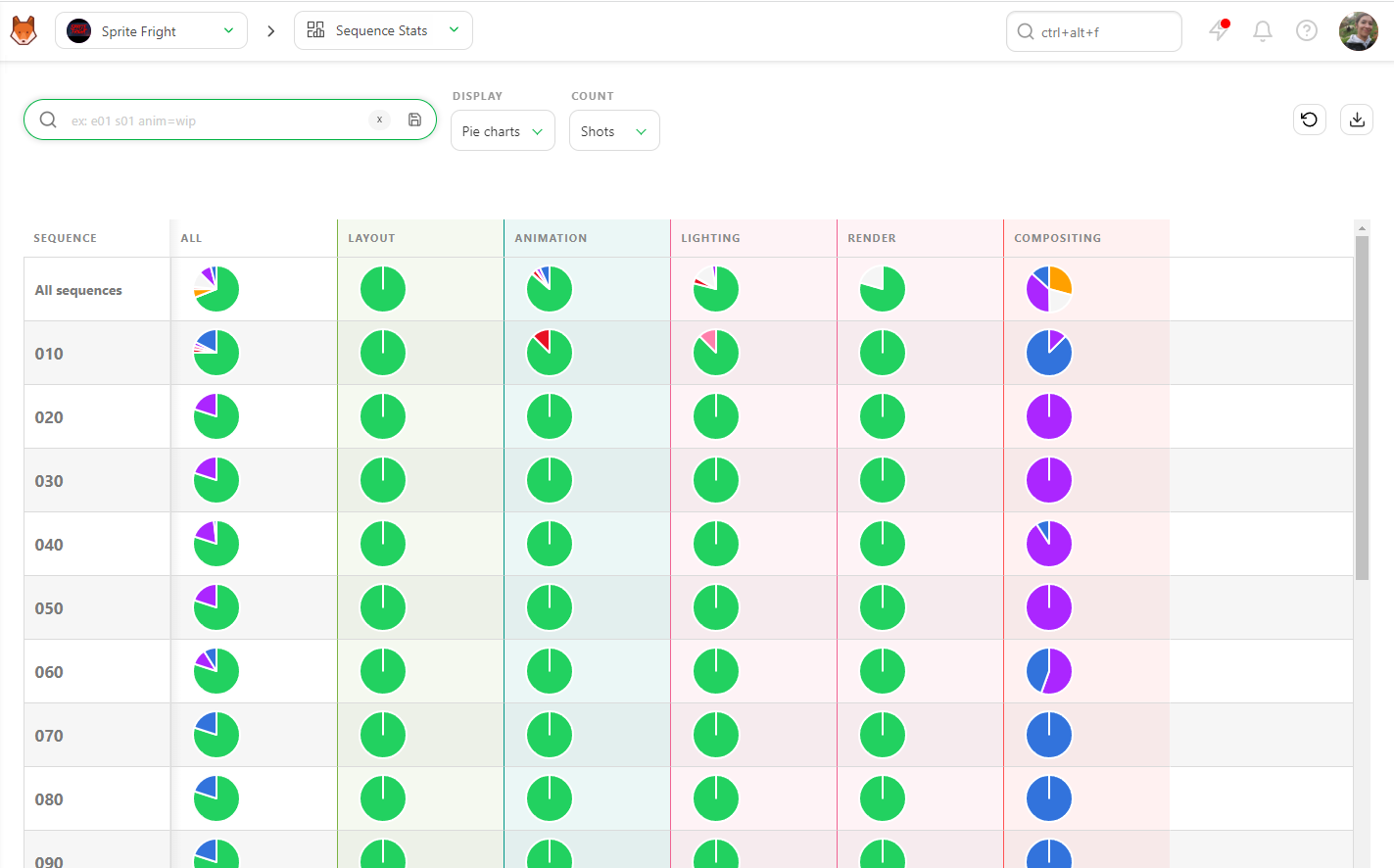
- All Sequences: The first line represents the whole production.
- All Tasks: The first column includes all tasks simultaneously.
By focusing on the first pie chart, you can see the exact state of your production. For more details, look at the rest of the line to get a global view of each task type's state.
# Asset Types Stats
Similar to Sequence Stats, the Asset Types Stats page provides pie charts for asset types, giving you a clear view of the asset status across the production.
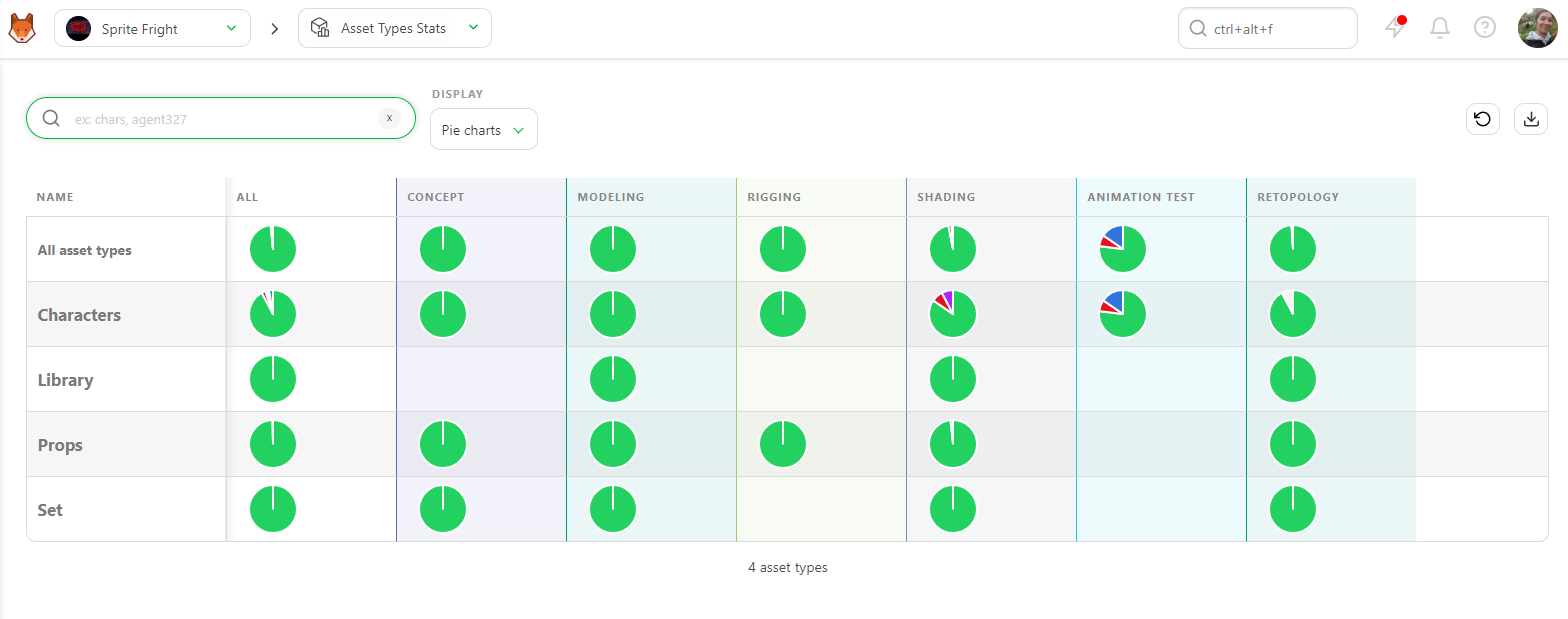
# Count View
You can also display data as Counts to see the exact number of assets, shots, or frames, along with their percentage per status.
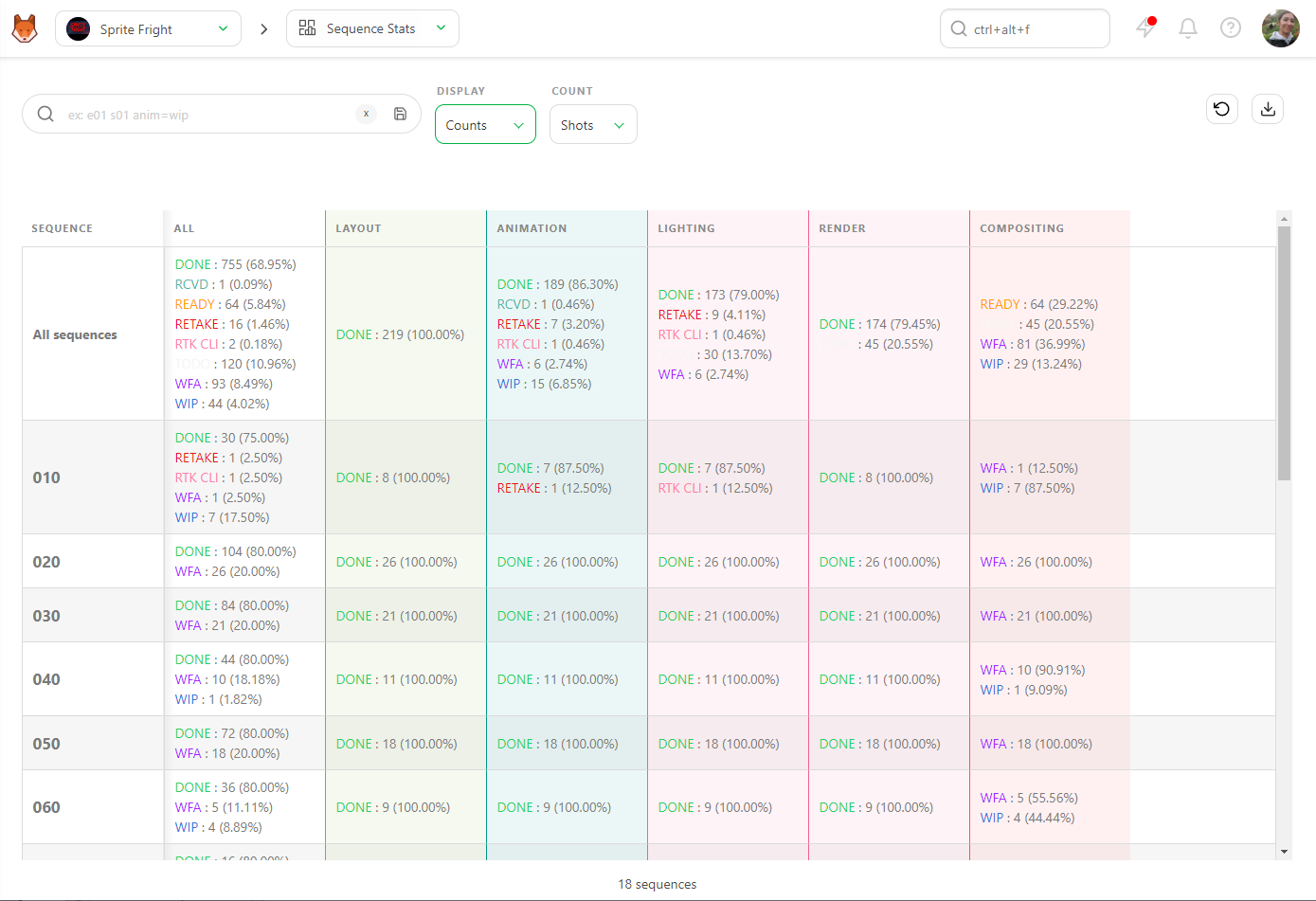
# Exporting Data
You can export this page as a .csv text file and import it into spreadsheet software for further analysis and reporting.
By leveraging these tools, you can stay on top of the production process, ensuring everything runs smoothly and on schedule.
# TV Show Specific
You can access an extra information level on a TV show through the Episodes Stats Page.
# Retakes Display
The default setting for the Episodes Stats page is Retakes. This display lets you see the number of retakes (back and forth) for each episode on each task type. Only three colors are displayed:
- Validated as Green
- Retakes as Red
- In progress as Grey
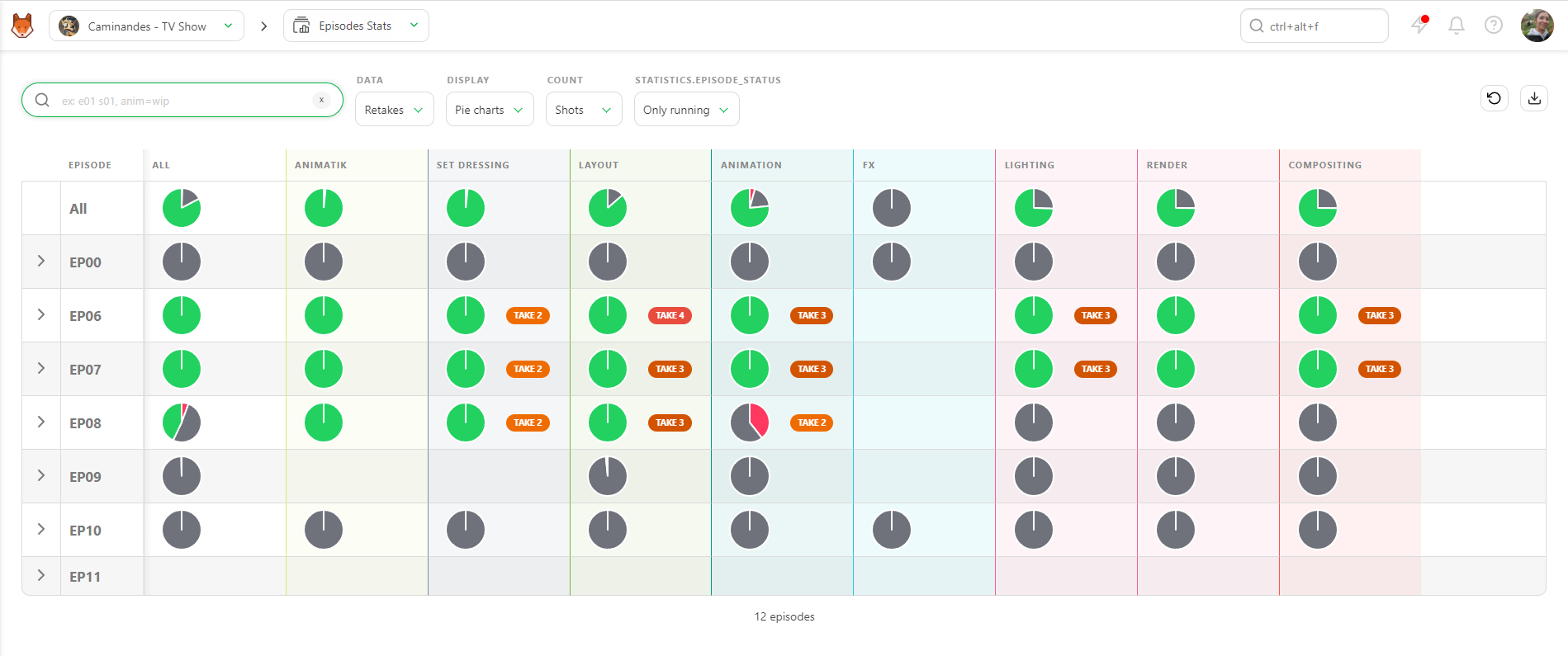
If you unfold an episode, you will see the percentage of each take and the evolution of the retakes versus approval. This helps you see the progress of each episode per task.
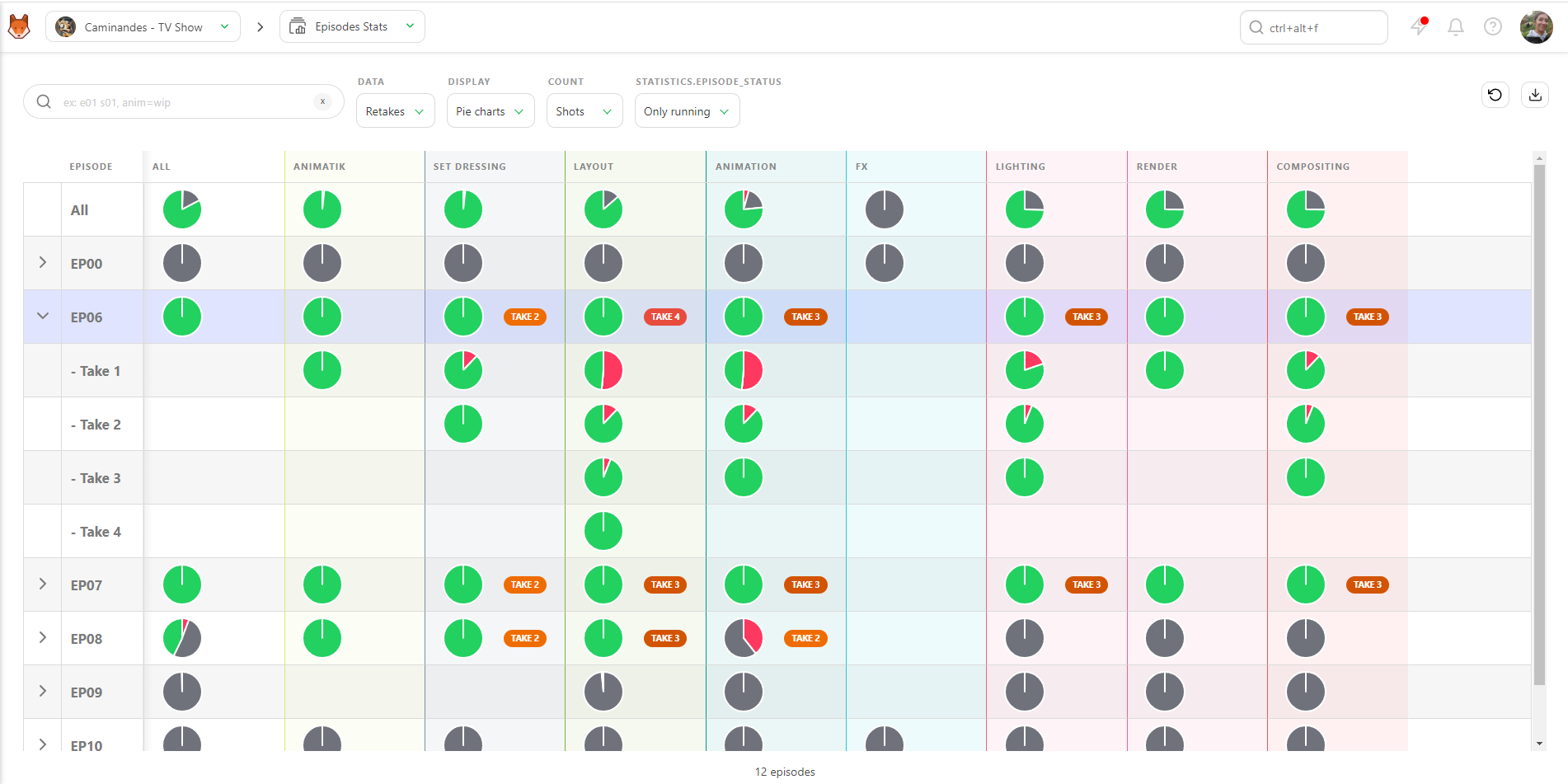
Usually, the first episodes have many back-and-forths, but it should get better over time. However, if late episodes still have many retakes, something must be fixed. It's time to discuss the issue with the director and the supervisor.
# Status Display
The second option for data display is Status. This status display works like the Sequence / Asset Type Stats page.
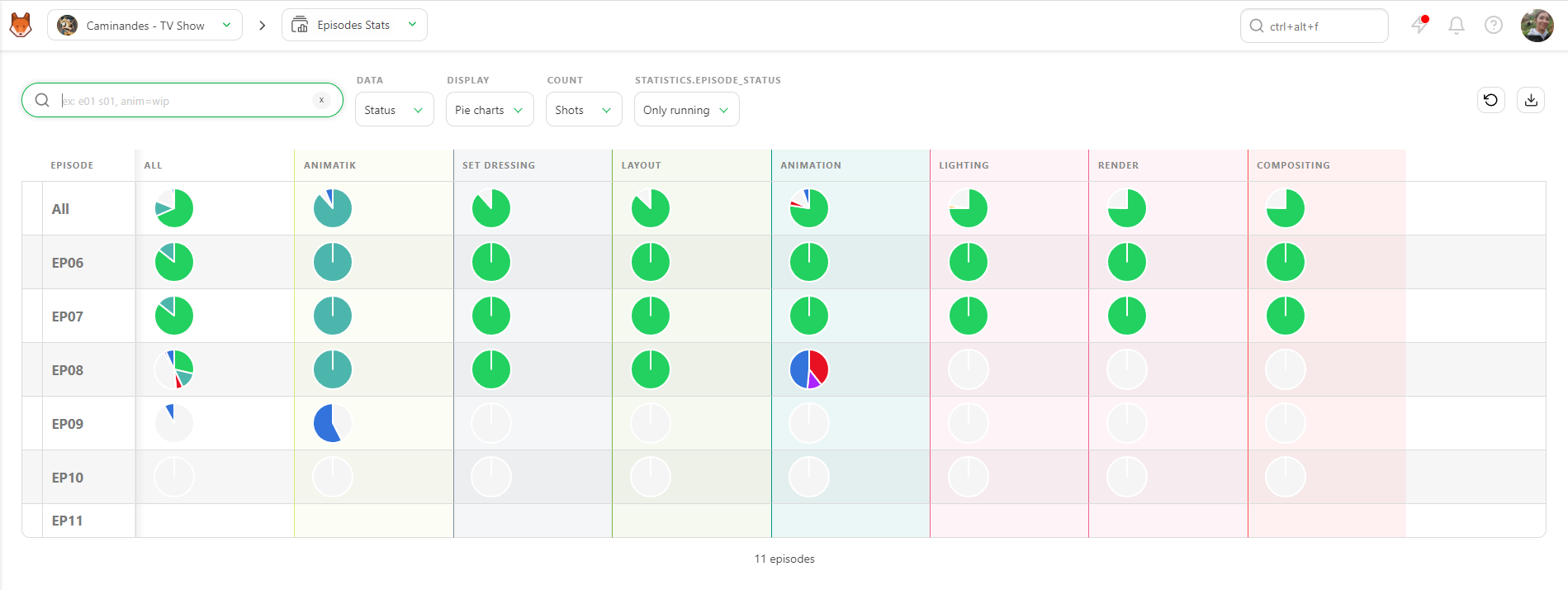
You can also display data as Counts. This way, you'll see the exact number of shots/frames with the percentage per status.

You can export this page as a .csv text file and import it into spreadsheet software.
# Ensure Tasks are On Time
To know if a task is on time, you need two things:
- The Task Type of the task
- An Estimation (Bid) in days, along with an estimated Start date and Due date for the task.
Once this information is entered, you can compare estimation to reality on the Task Type page.
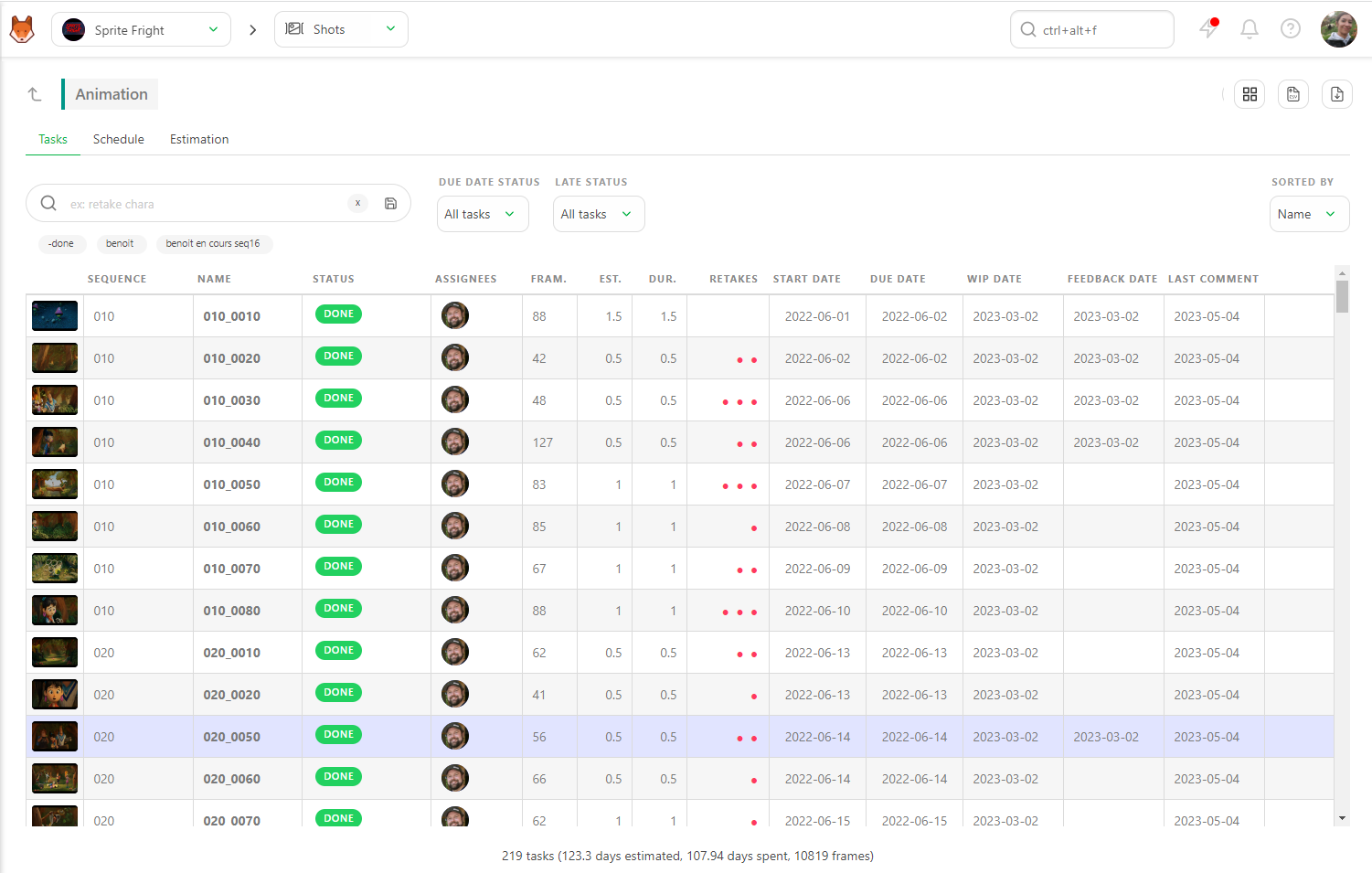
# Methods to Compare Estimations and Actuals
There are two main ways to do this:
- Filtering by Due Date Status
- Using the Gantt Diagram
TIP
Kitsu automatically grabs the date and status of WIP (Work in Progress) and WFA (Waiting for Approval). You can compare your estimated start date versus when the Artist really starts, and compare the estimated due date to when the Artist asks for approval.
# Filtering by Due Date Status
On the Tasks tab, the first filter you see is Due Date Status. Set it to Due before today to display all tasks with a Due date set Due Before Today.
Next, to determine what is finished and what still needs to be finished. Use the -Done filter to exclude completed tasks.
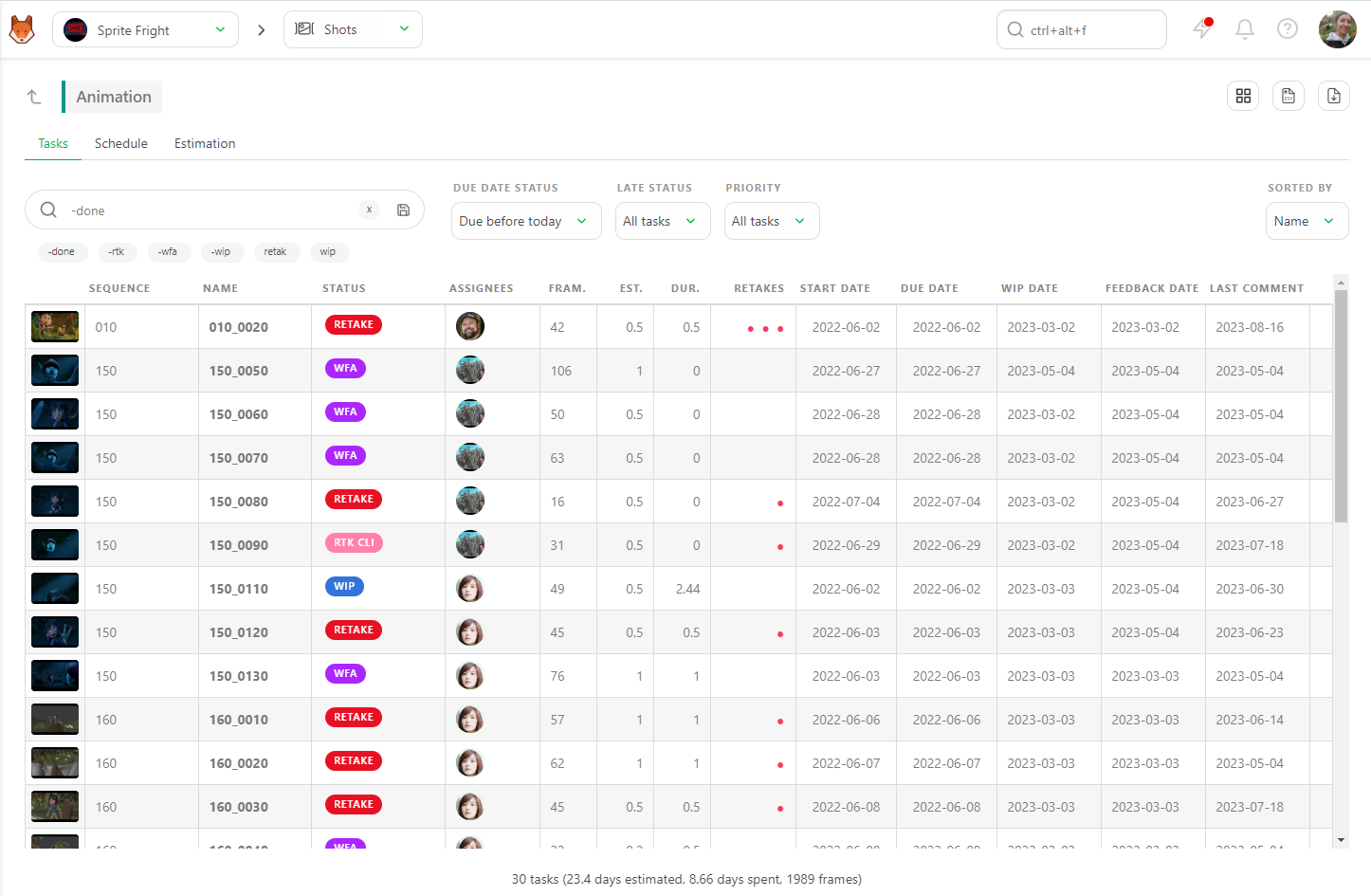
This will show you all the late tasks with the two filters applied, meaning they are only validated after the Estimated Due Date. The summary at the bottom of the page updates in real time based on the applied filters.
You can export this page as a CSV file and open it with spreadsheet software.
# Using the Late Status Filter
The Late Status filter built into the page helps you immediately see which tasks took more time than estimated (Estimation over Duration).
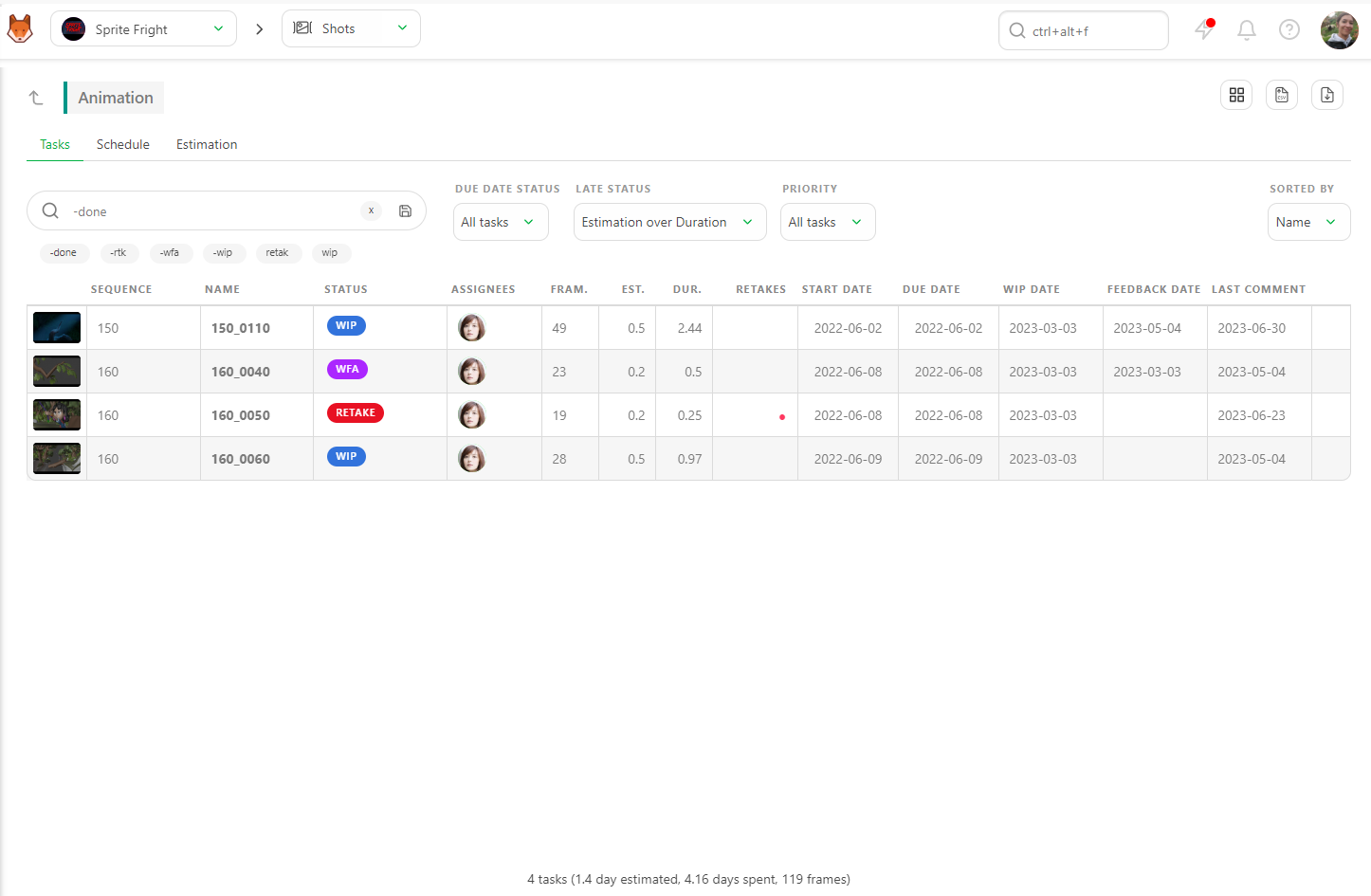
Filter the late tasks using the Due date late option. There are two ways to calculate if a task is late:
- Estimated due date versus Feedback
- Estimated due date versus Done
Depending on your studio's calculation method, Kitsu will provide the answer.
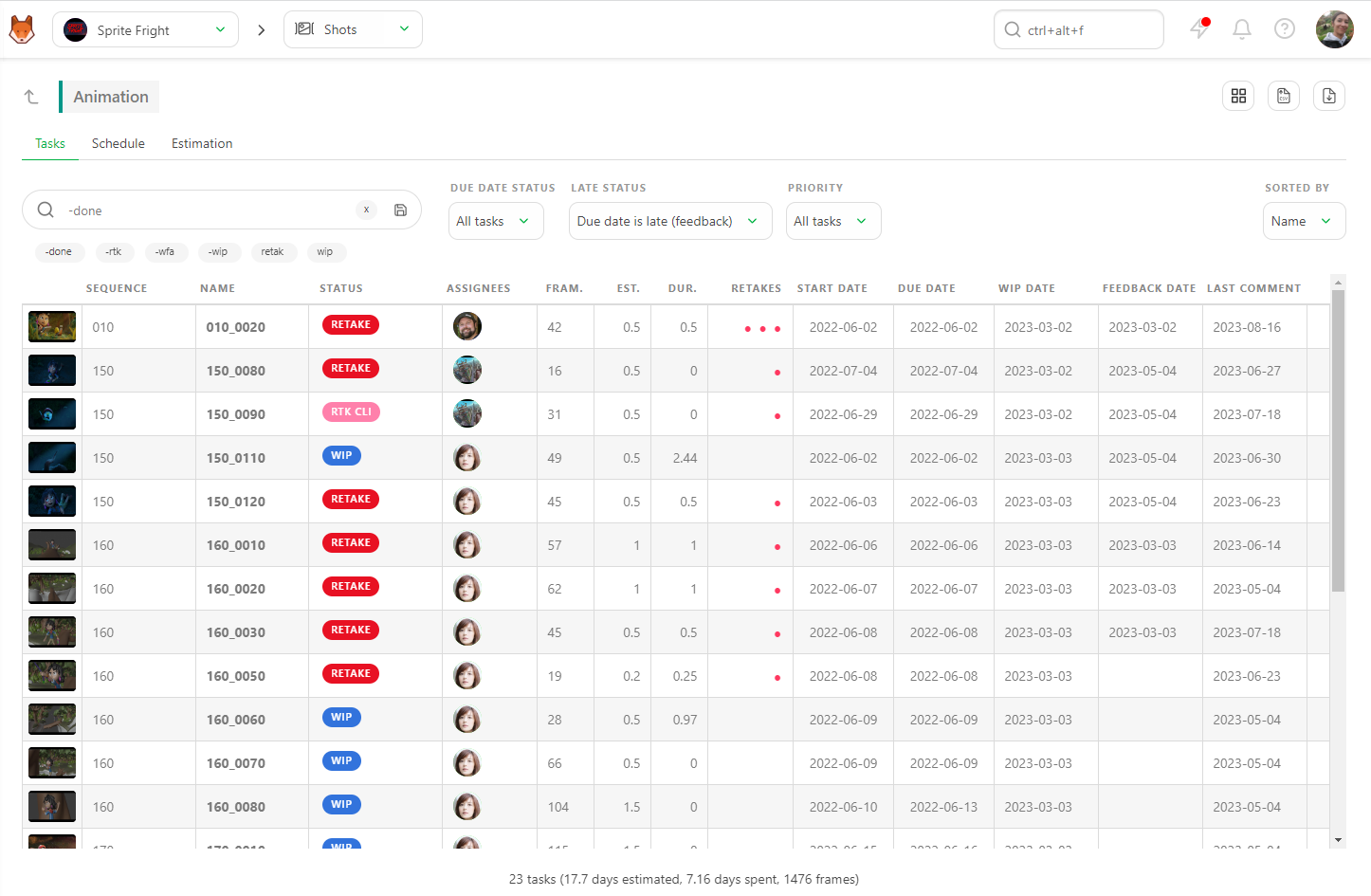
# Using the Gantt Diagram
On the Task Type Page, go to the Schedule tab. The Start and End dates of this task type, as set on the production schedule, are visible at the top of the screen.
The Gantt Diagram will be dark grey before and after these dates, providing a visual cue for task timing.
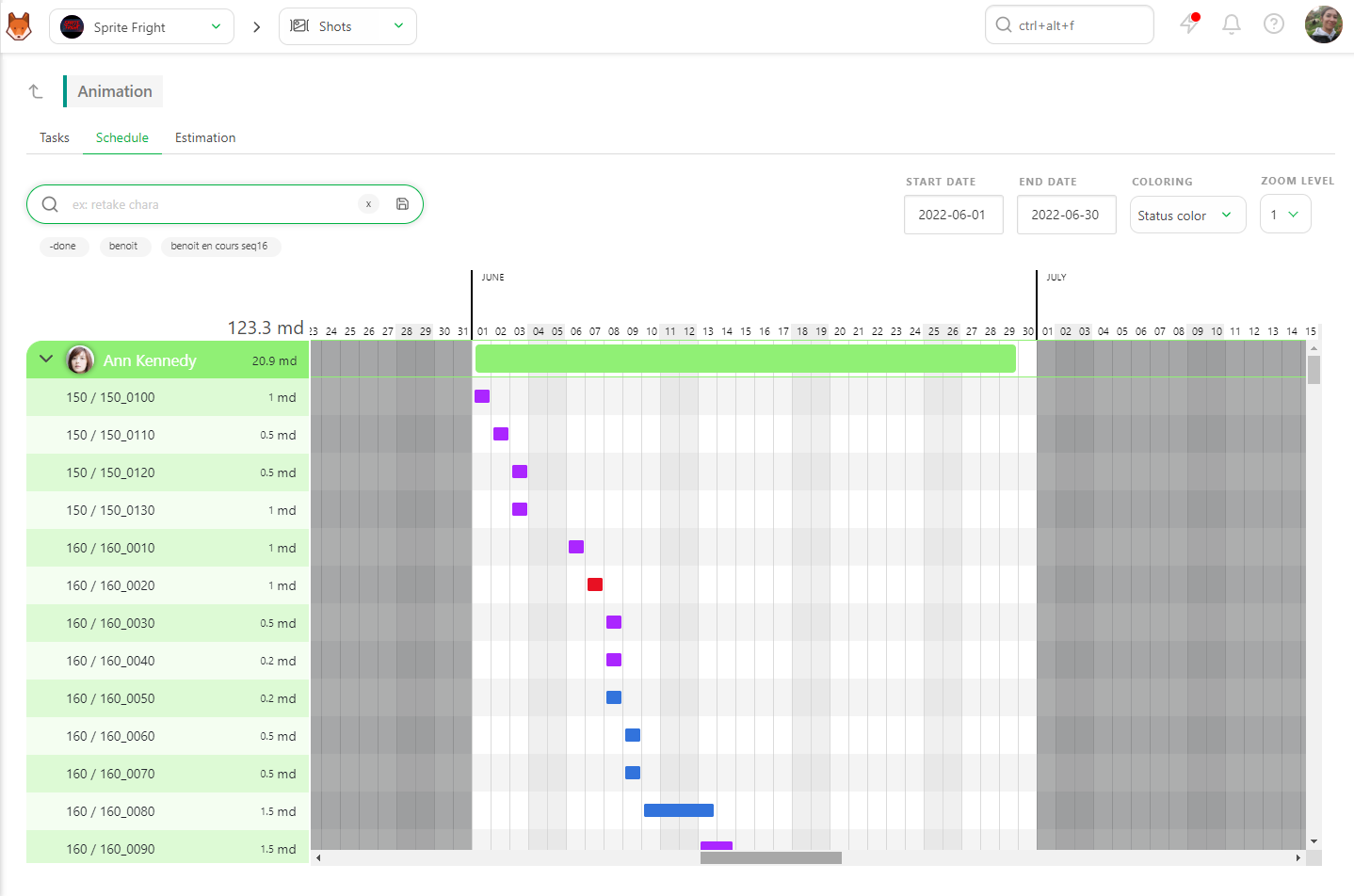
Change the Coloring from Status color to Late in Red. This will show tasks in Grey if they are on time and Red if they are late.
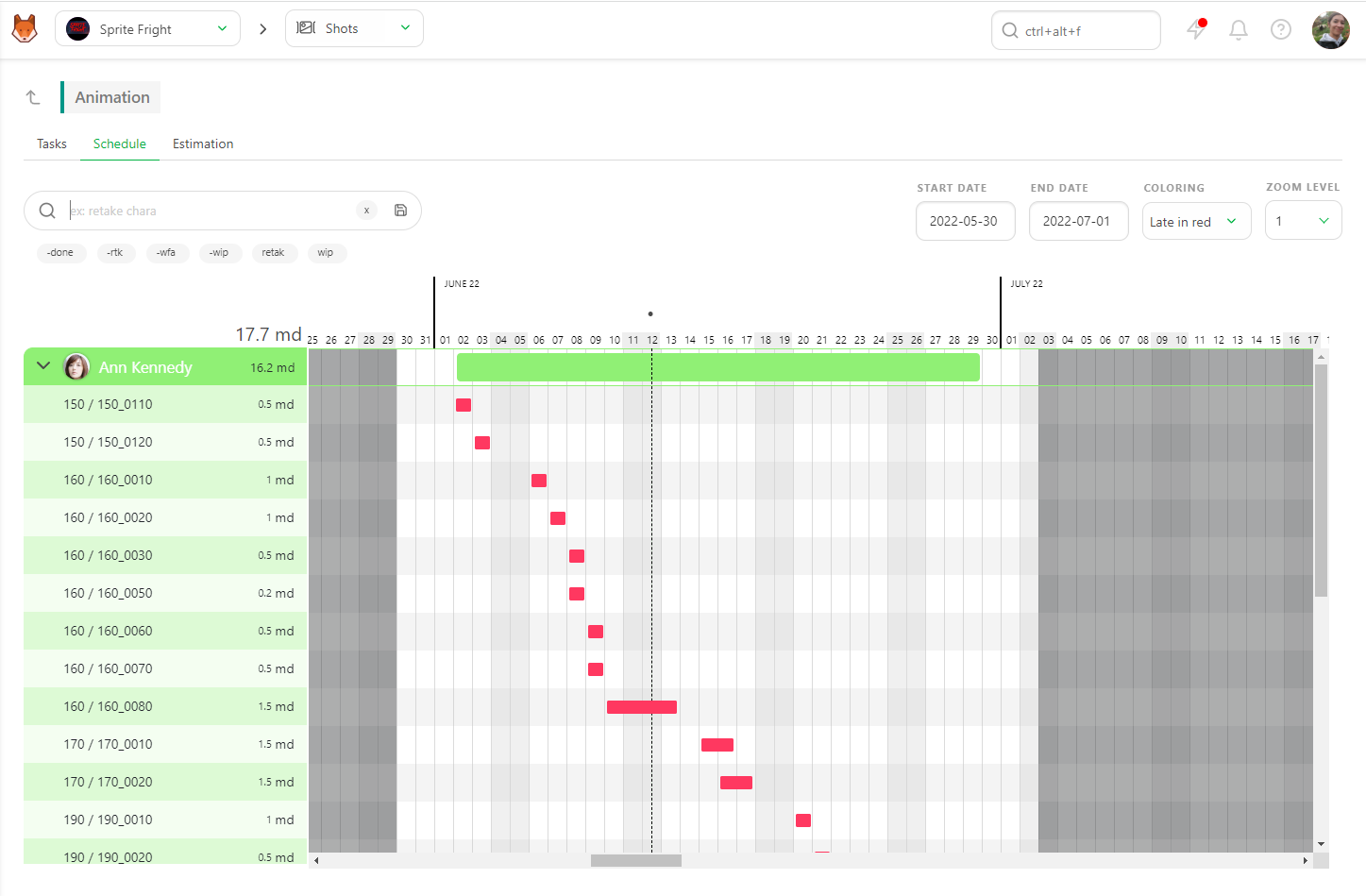
You can return to the Tasks tab for more details, and Kitsu will retain your filters from tab to tab.
# Understanding Why a Task is Late
Now that you know which tasks are late or will be late, you need to understand why. There are several reasons why a task might be late:
- The artist is overwhelmed with too many tasks.
- There is too much back-and-forth on the task.
- The task might be underestimated, making it difficult to finish on time.
- The previous task was already late.
# Checking an Artist's Workload
To check an artist's number of tasks, filter the Task Type page by the artist's name under the Task tab.

You can also add the -done filter to see what the artist has left to do. Then add the Due Date Status filter to Due previous week or Due this week, depending on what you are looking for.
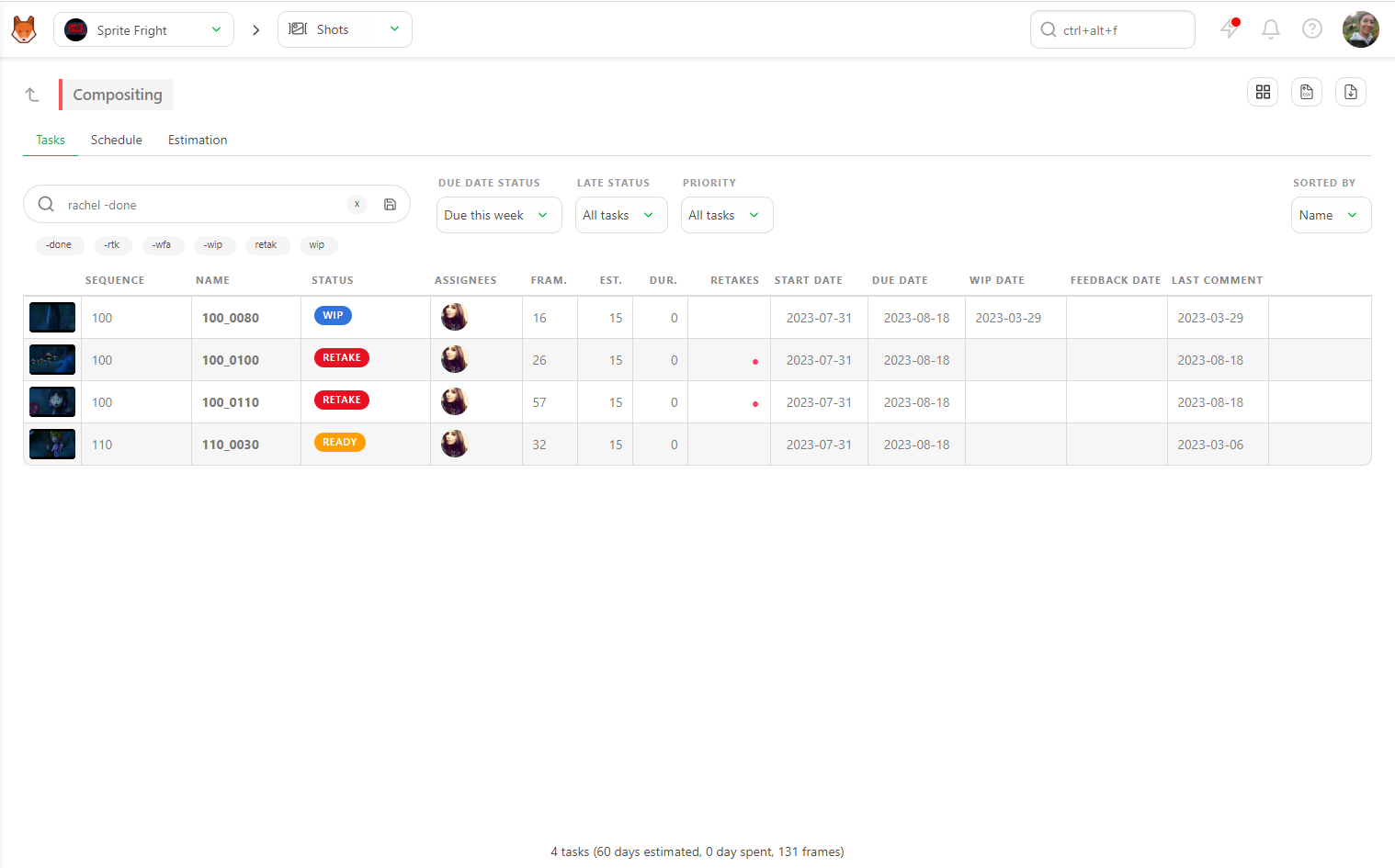
This will show you how many tasks your artist has to complete.
# Identifying Back-and-Forth
To identify the number of back-and-forths, look at the Retakes column on the Tasks tab. Each Red Dot represents a retake. Click on the line to open the Comment panel and read the entire task history. This is the best way to understand what is happening—whether the artist misunderstood the brief or if the brief changed with each version.
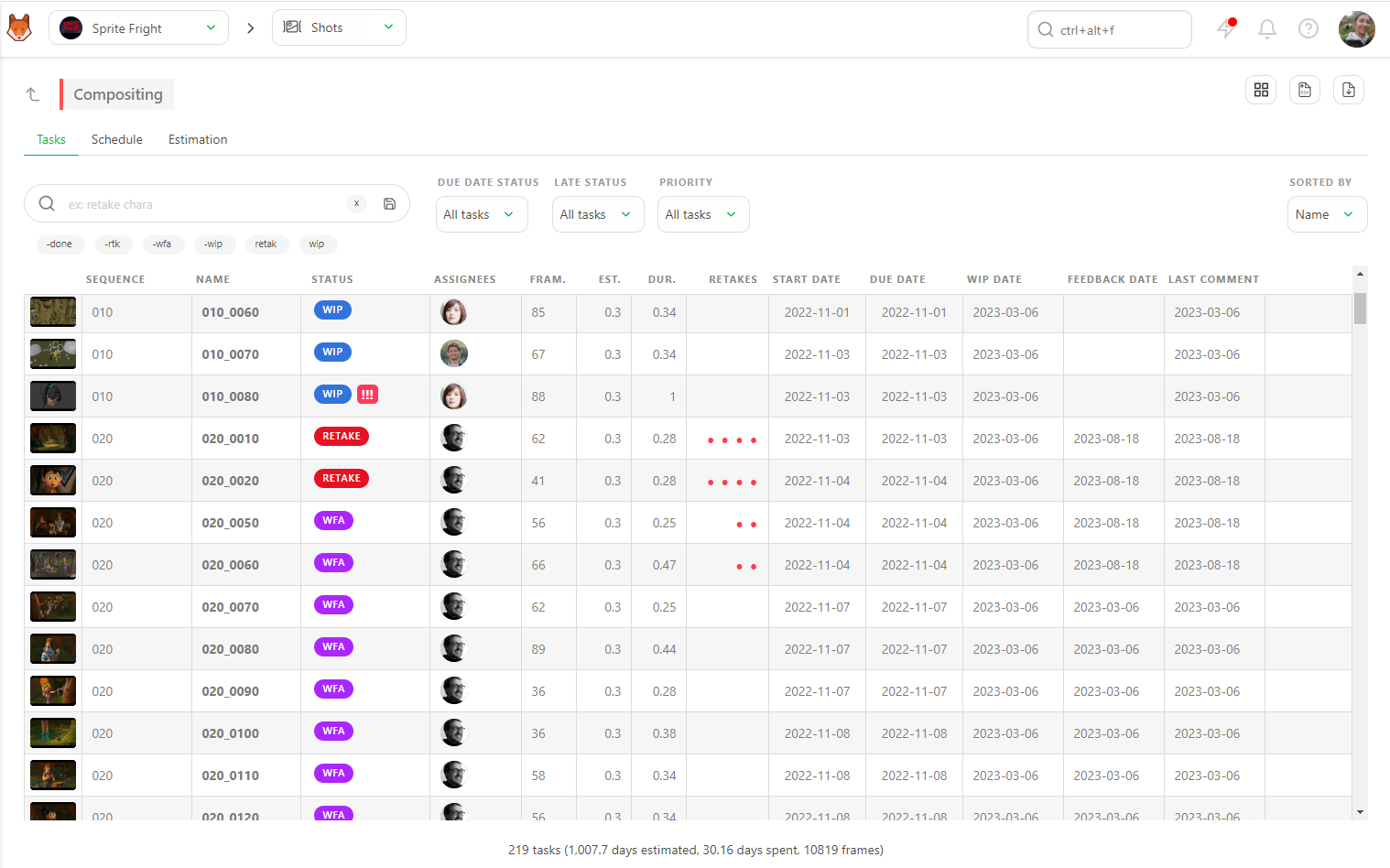
# Checking if the Task is Underestimated
To check if the task is underestimated, go back to the global page, click on the name of the shot or asset, and see the casting and all the extra information. For example, there might be too many characters in the scene, or it might be a big action scene.
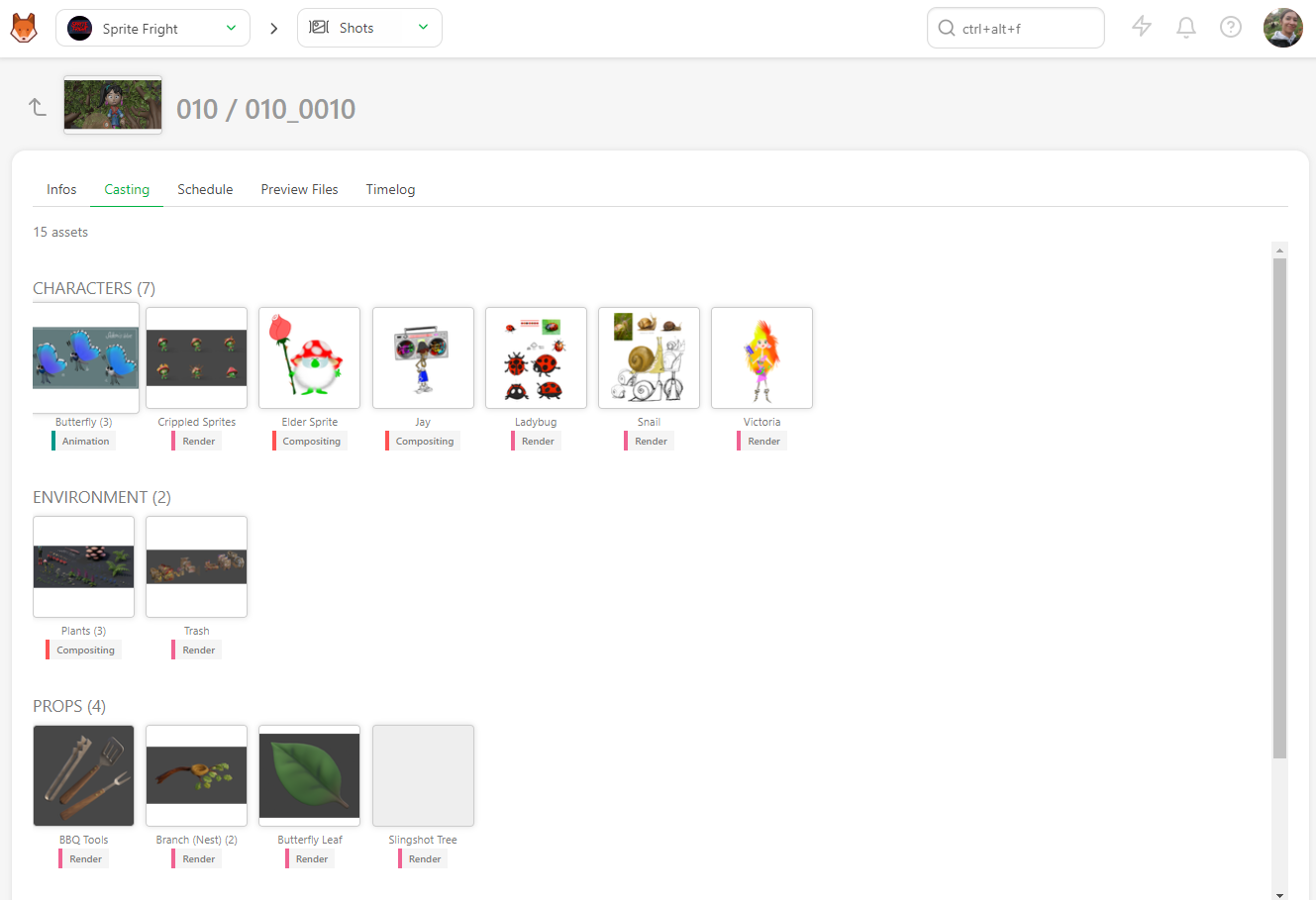
# Checking the Previous Task
Lastly, you can check the previous task while viewing the asset/shot in detail. Click on it to go to the dedicated Task Type page, where you can find detailed information about what was happening before. This can help you understand if delays in earlier tasks are affecting the current one.
# Durations over Estimates
To focus on the big picture and have a global view of the Bid, you can compare the estimated Person days versus the reality Days Spent on various pages.
# Estimation Summary
On the shots' global page, you can see the sum-up of all the estimations versus duration. You can also apply filters for more specific insights.
For example, to focus on a specific sequence, filter your global page by the sequence's name. The sum-up at the bottom will update accordingly.
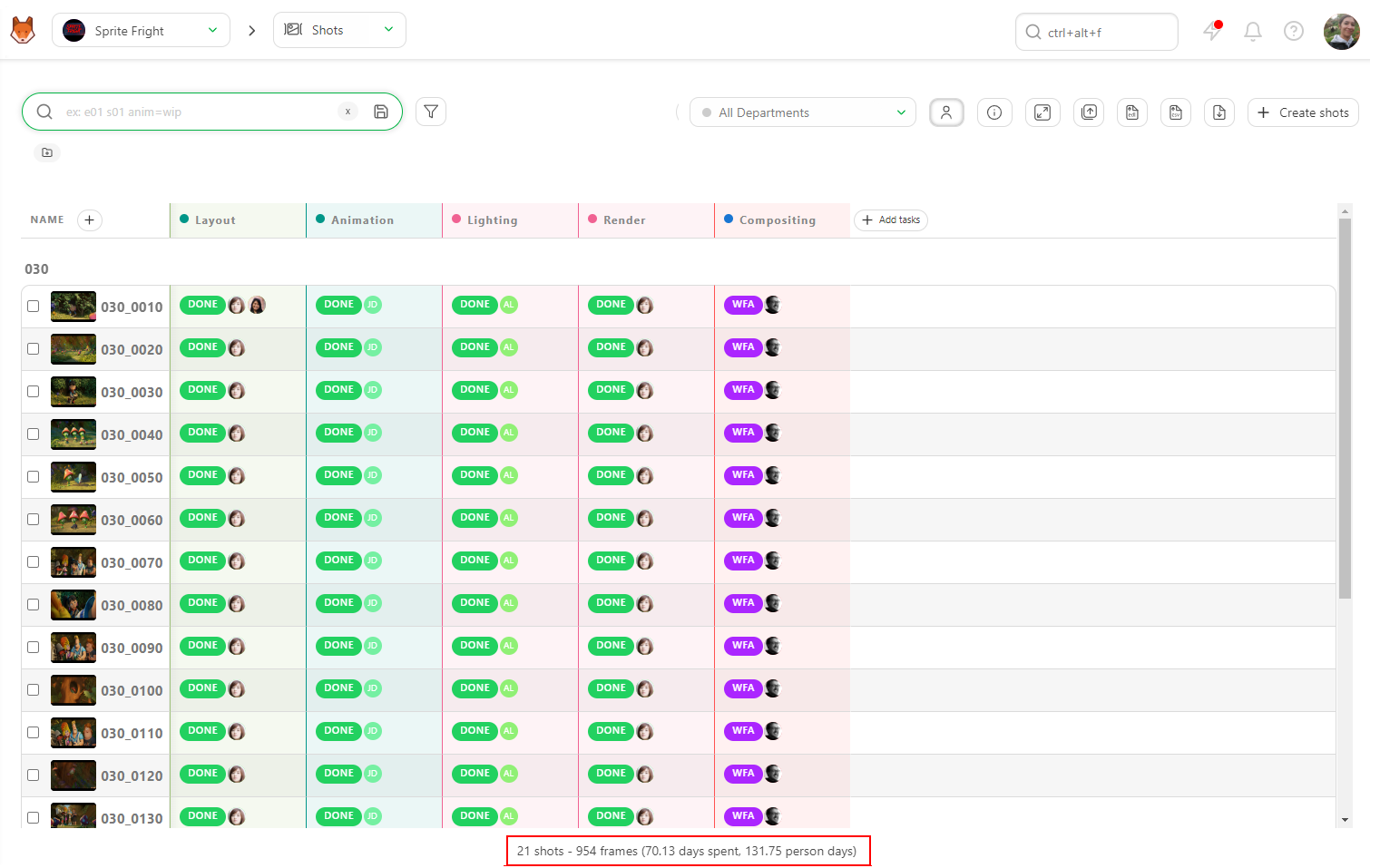
This allows you to know the Duration versus Estimation for that particular Sequence.
Similarly, you can filter the global asset page.
For example, you can filter by a specific Asset Type such as Character. The sum-up at the bottom will update to show the estimation versus duration for that asset type.
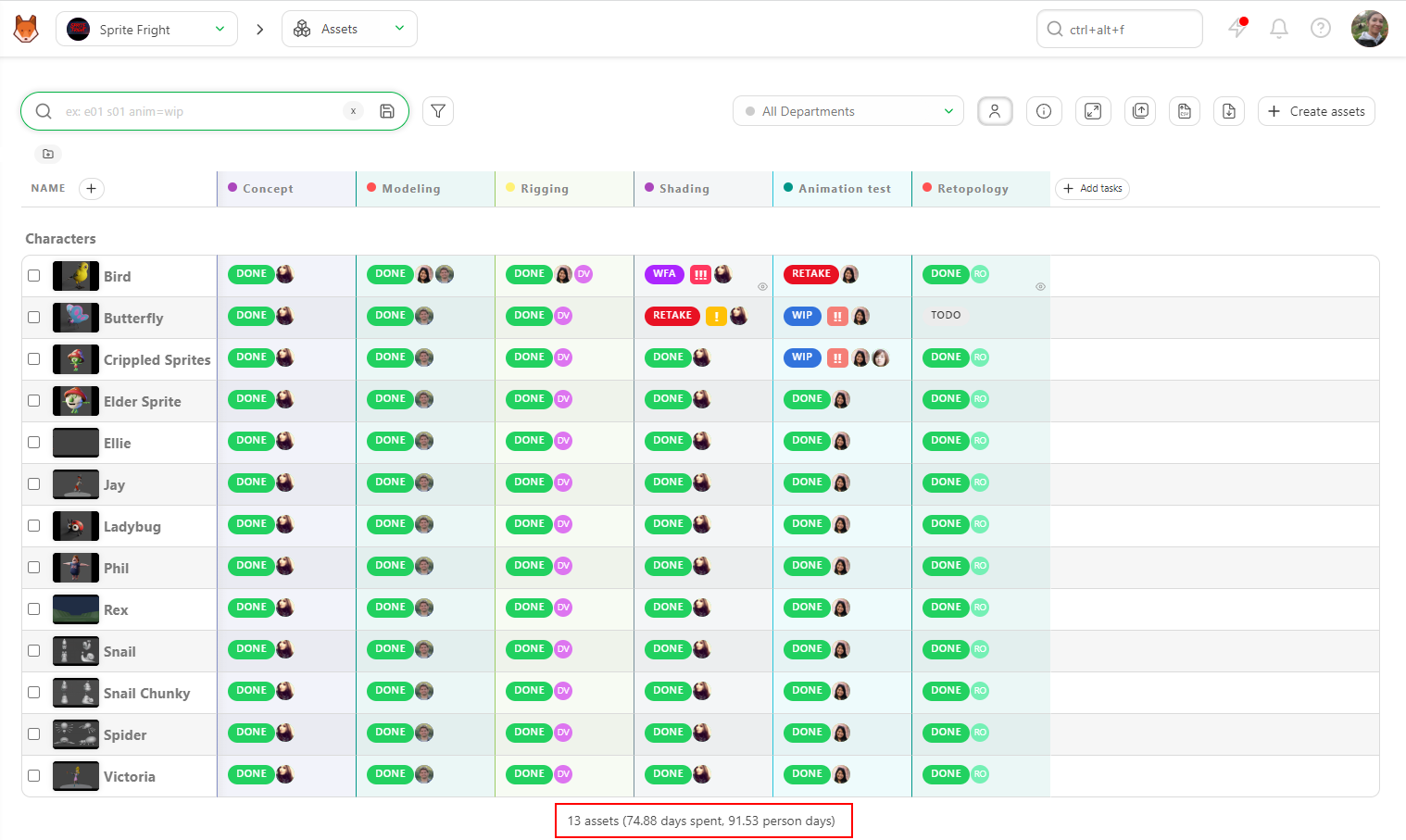
# Task Type Duration over Estimation
To delve into details, click on the name of a task type. The sum-up at the bottom of the screen will show Duration versus Estimation for this specific task type.
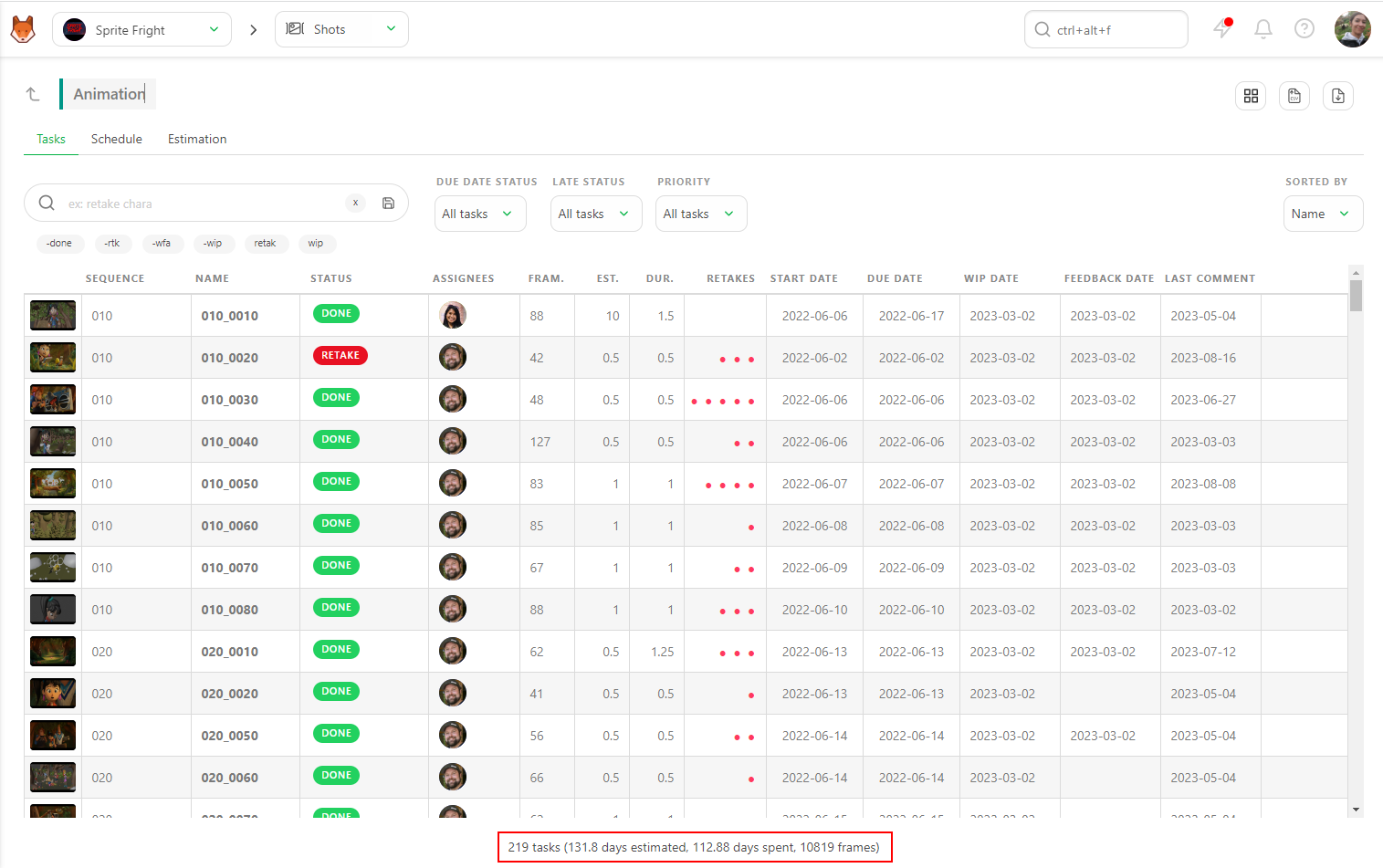
You can get a global view or focus on a specific status or Artist's name. As on the global page, the sum-up will update with each filter applied.
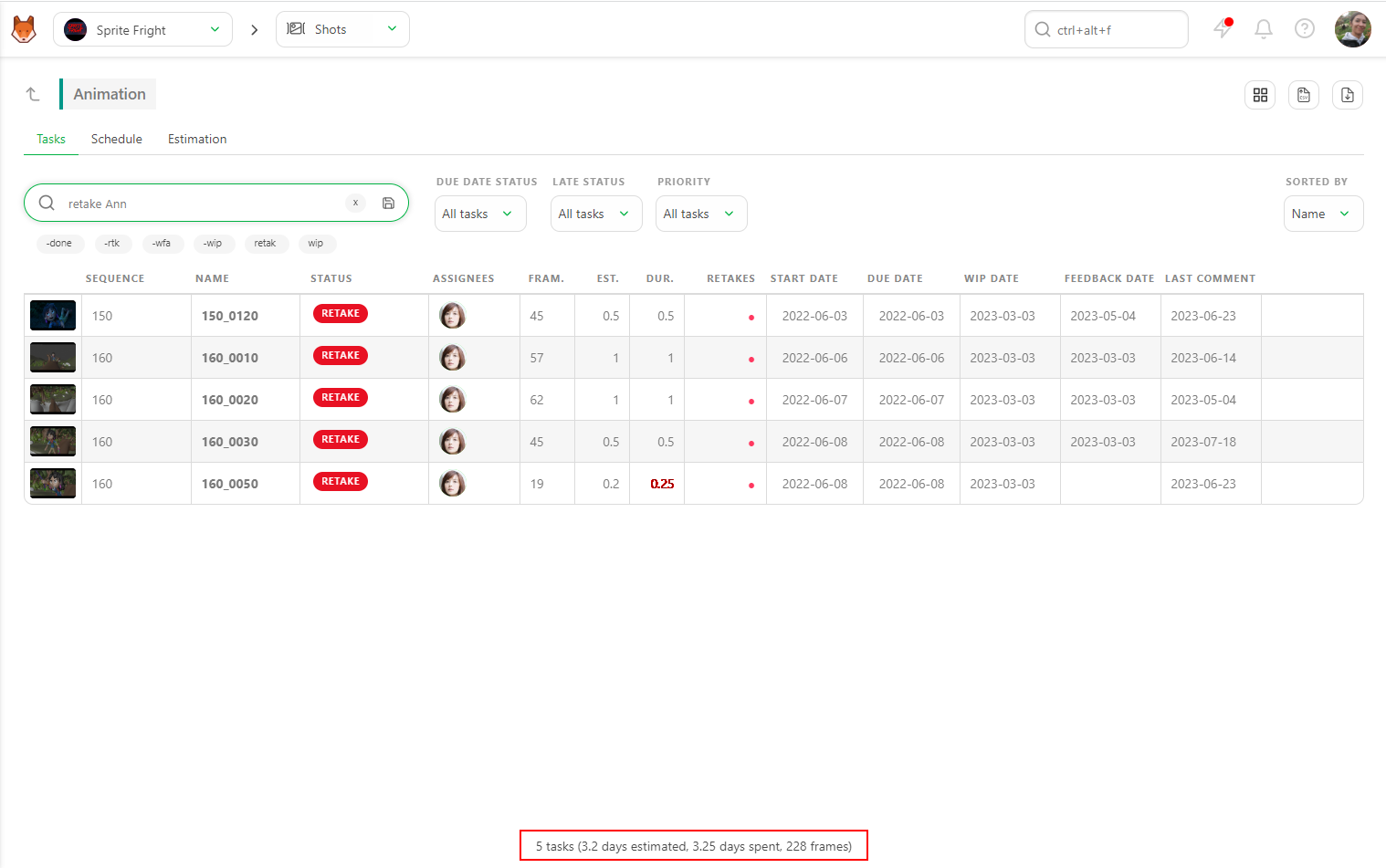
This way, you can closely monitor the performance and efficiency of specific tasks and artists, ensuring that estimations align with actual durations and making adjustments as necessary.
# Durations over Estimations for an Asset / Shot
To closely examine the details, you can display Estimation and Time Spent columns (duration) for each asset and shot in Kitsu.
On the global page for shots or assets, you can see the sum-up of each task's Estimation and Duration. This allows you to quickly identify discrepancies or issues.
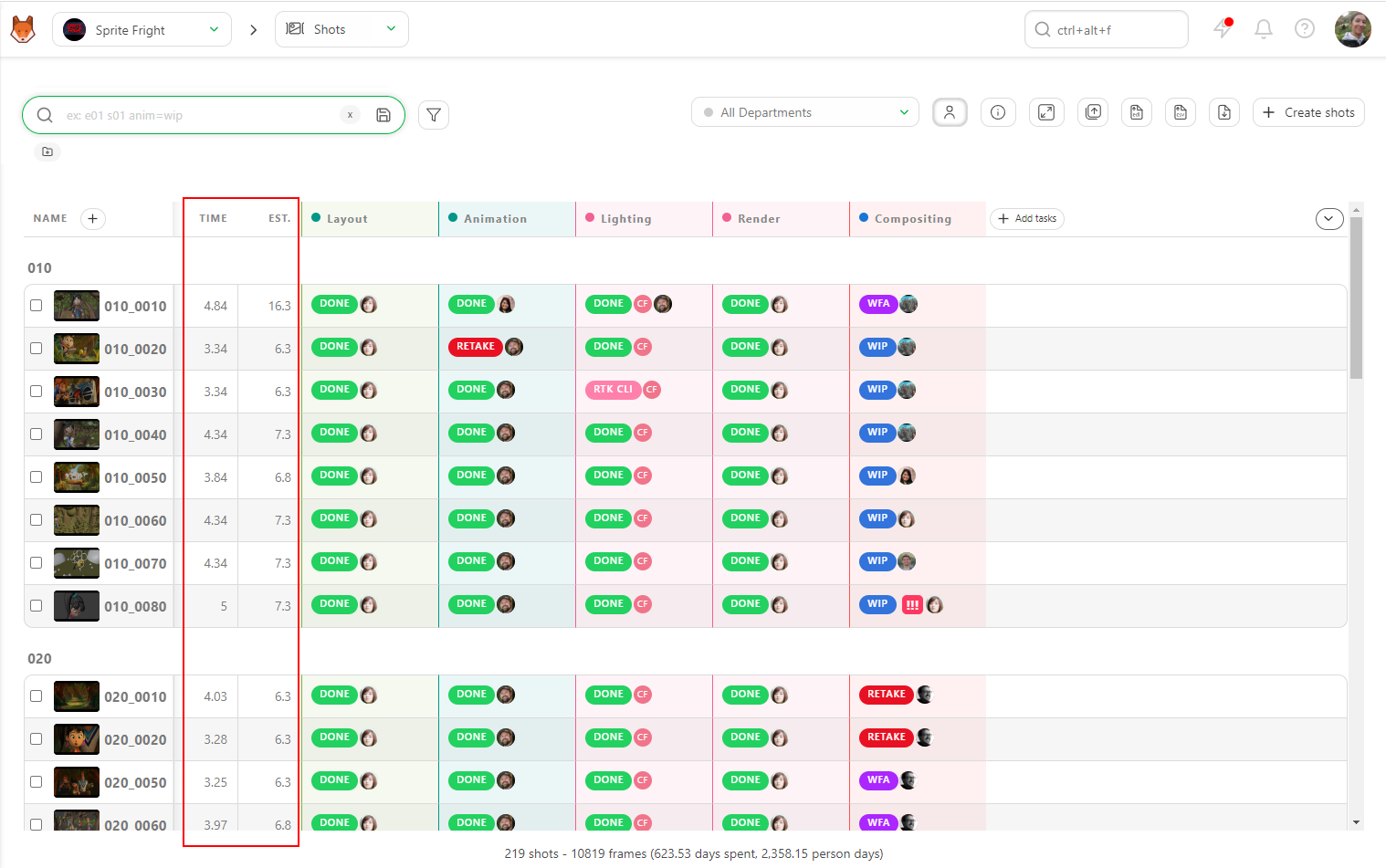
# Detailed Analysis
If something appears wrong or needs further investigation, click on the asset or shot name to go to the detail page.
On the detail page, at the top left of the screen, you'll find a summary of the asset's or shot's lifecycle. This includes details of each task's Status, Estimation, Duration, Start and Due Date, and Assignation.

This comprehensive view helps you understand where the discrepancies lie and take corrective actions if necessary. By closely monitoring these details, you can ensure better alignment between estimations and actual durations, leading to more accurate future planning and resource allocation.
# Checking Quotas
Kitsu provides two methods for calculating quotas per shot Task Type.
# Method 1: Timesheet-Based Calculation
This method weights quotas according to the time spent on tasks as recorded in the timesheets.
- Task Completion: Shots are considered completed upon the first feedback request. The quotas are then weighted based on the time recorded in the timesheet.

In this example, Kitsu calculates the daily quota using timesheet data.
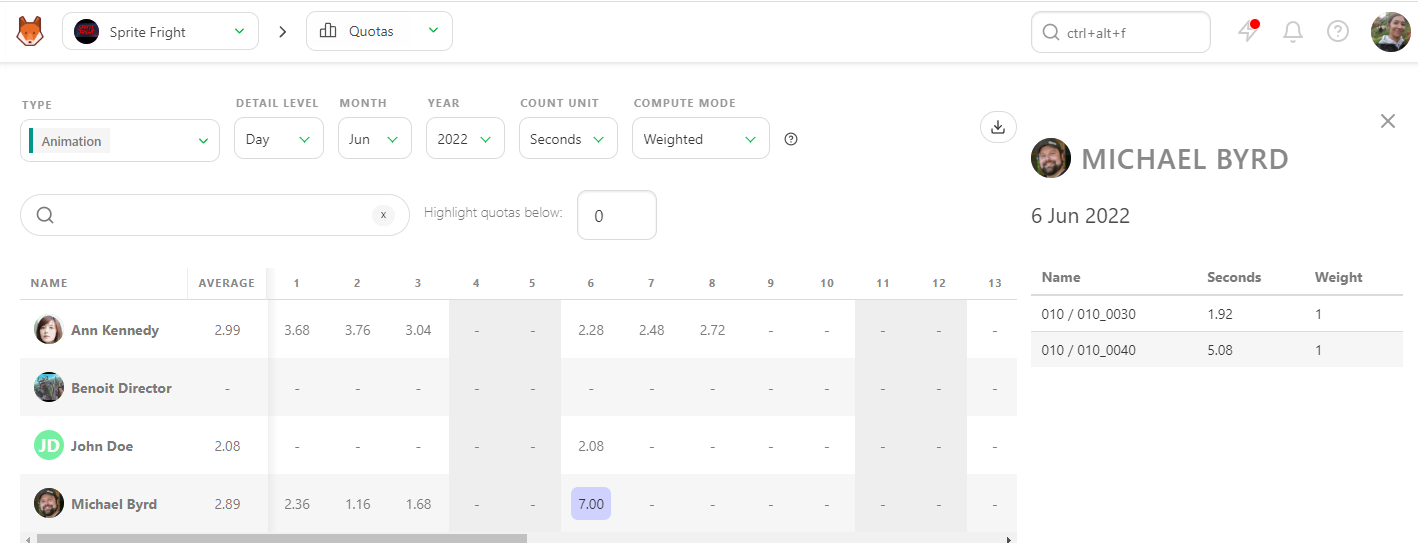
# Method 2: Status-Based Calculation
If no timesheet data is available, Kitsu uses status changes to calculate quotas.
- Task Start: The task is considered to have started when its status changes to WIP.
- Task Completion: The task is considered completed on the day the feedback request is made.
# Detailed Quota Calculation
Kitsu splits the completed frames among all business days between the task's start and end dates, attributing the number of frames (or seconds, or tasks) submitted per day/week/month to each artist.
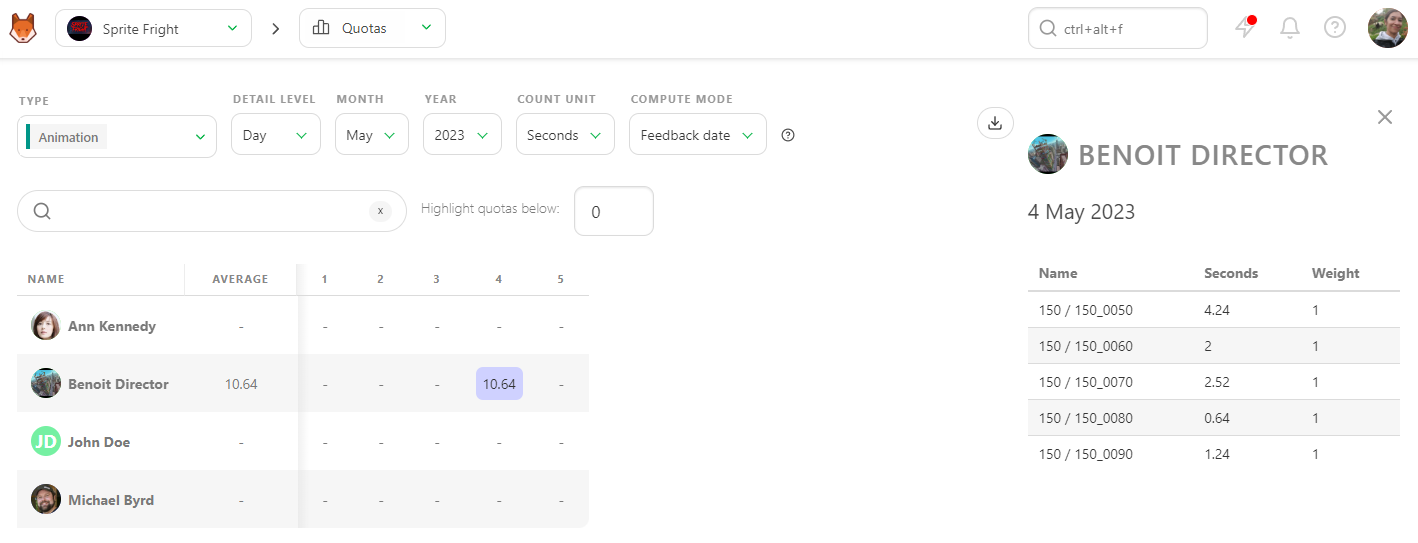
At any point, you can click on a number to see detailed information in the right panel.

DANGER
Note: If no timesheet is filled, Kitsu defaults to considering:
- The task started with the first status change to WIP.
- The task was completed on the day the feedback request was made.
This method ensures that even in the absence of detailed timesheet data, there is a reliable way to track task progress and calculate quotas accurately.
# Team Timesheets
WARNING
All of the previous chapters are based on the fact that Estimation and Duration are filled for each task.
Everybody has to do their part. You and the supervisor will handle the estimation, while your team will fill out their timesheets.
Navigate to the main menu and select the Timesheet page.

# Viewing Timesheets
On this page, you can view each team member's timesheet by day. This allows you to check whether they fill it out daily, took a day off, or worked extra hours.
If you have a question about a timesheet entry, click on it to see the details of the production, task type, and specific task.
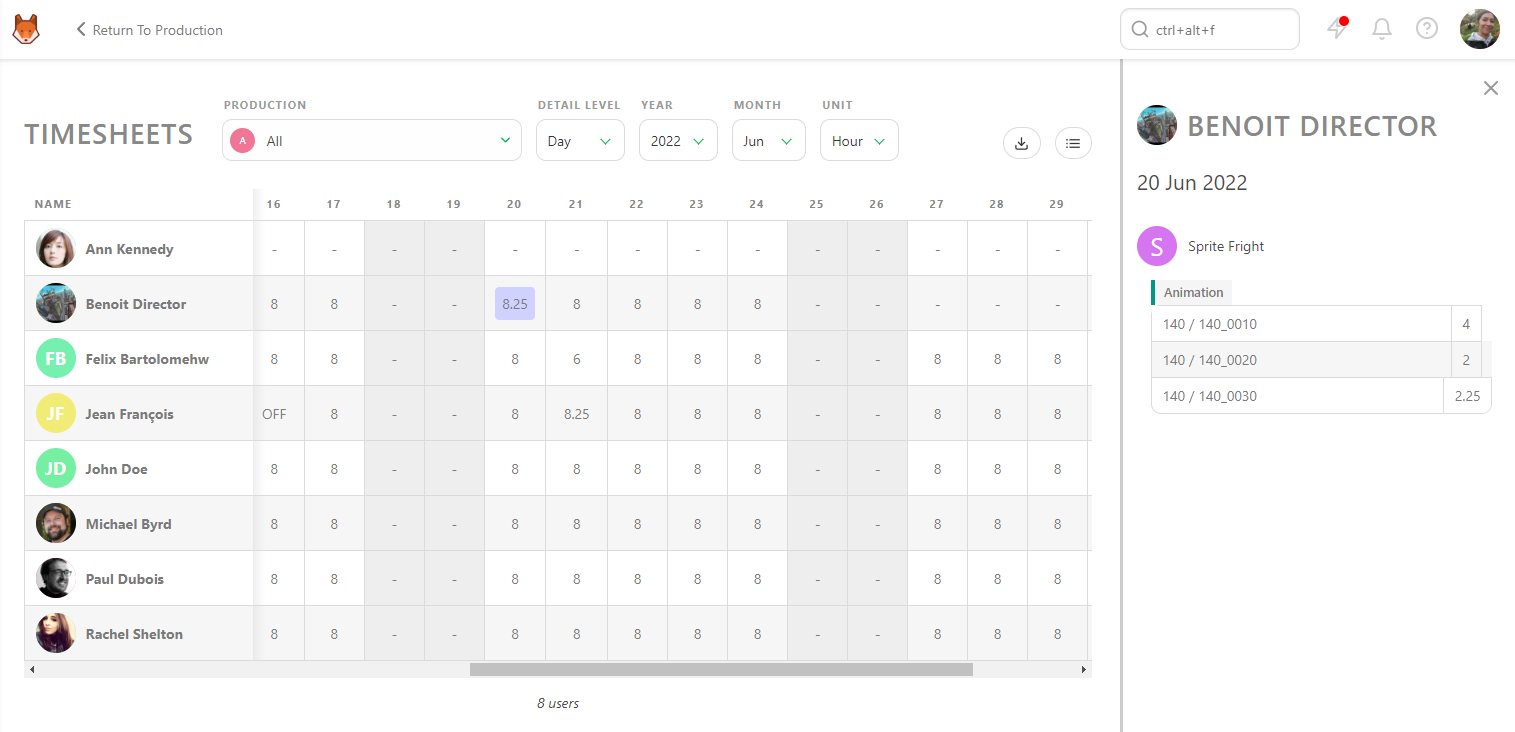
Once everything looks good at the day level, you can change the Detail Level from Day to Week, Month, or Year.
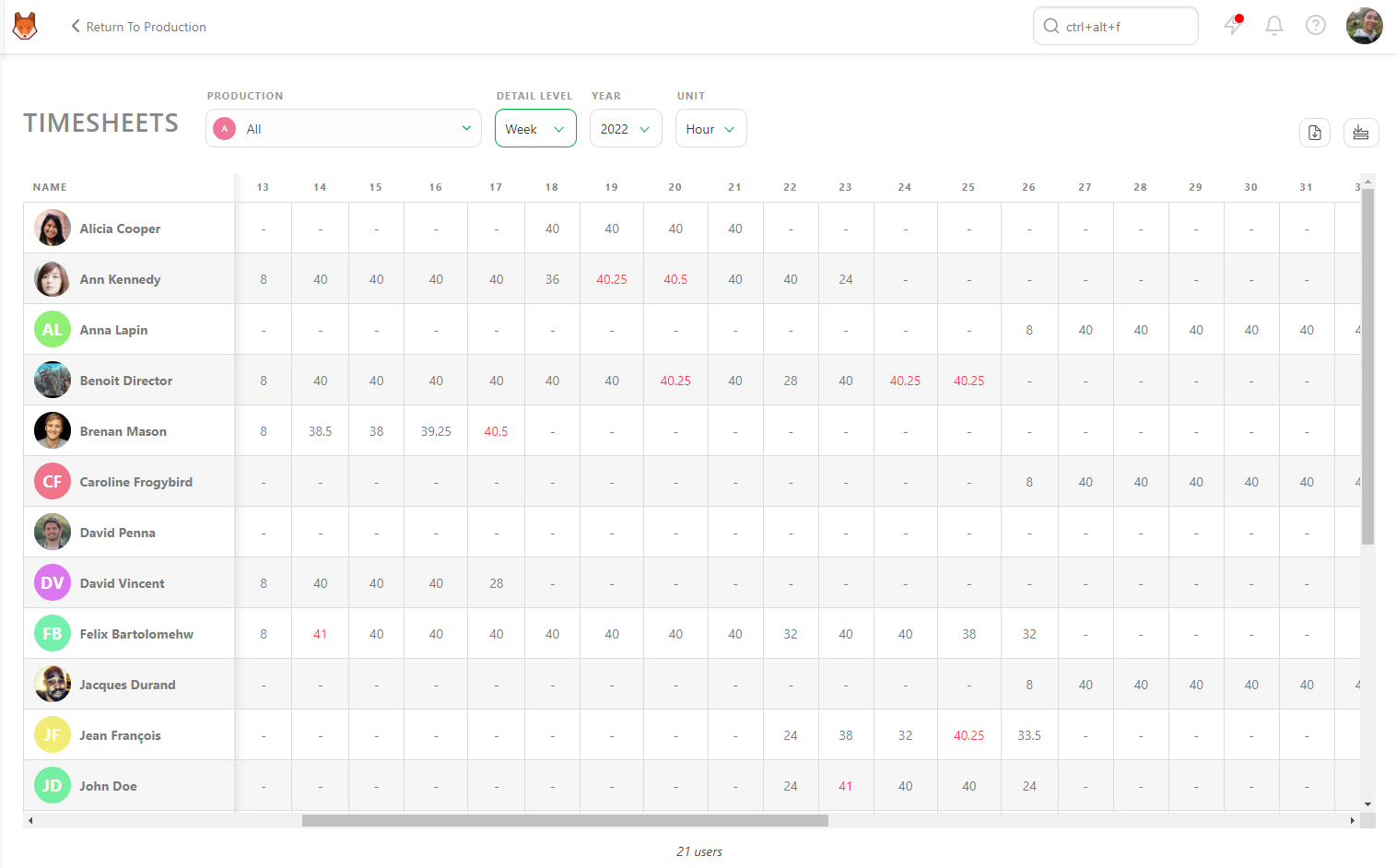
You can view all the productions you manage simultaneously or look at each production individually.
# Exporting Timesheets
As with all other pages in Kitsu, you can export the timesheet data as a CSV file and open it in spreadsheet software for further analysis.